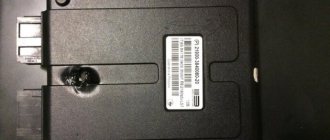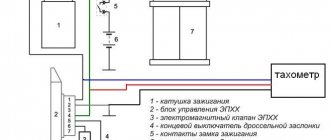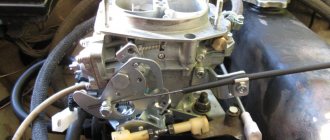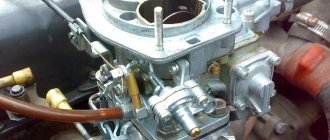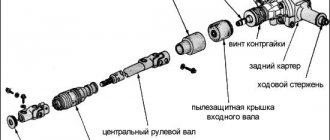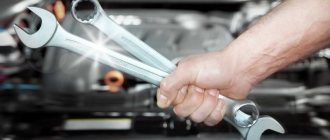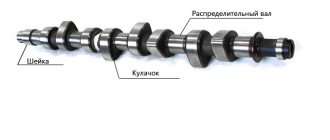↑ Diagram of the carburetor electro-pneumatic valve control system
1 - microswitch in the carburetor;
2 - pneumatic valve; 3 — mounting block; 4 - ignition relay; 5 — ignition switch; 6 — pneumatic valve control unit; 7 - ignition coil; A - to terminal “30” of the generator; B - order of conditional numbering of plugs in the control unit. A working control unit 25.3761 should turn off pneumatic valve 2 when the engine crankshaft speed exceeds 1600 min-1 and turn it on again when the speed drops to 1200 min-1.
Before checking the operation of the unit, you must make sure that the vehicle wiring harness is connected correctly to the control unit (see view “B” of the control unit connector).
The functionality of the control unit is checked using a tachometer and a voltmeter (with a measurement range of 0–15 V) in the following order:
- disconnect the wires from the microswitch installed on the carburetor;
- connect 1 voltmeter to the control unit using a special adapter connector 2;
- start the engine and, gradually increasing the speed, monitor the voltmeter readings: after starting the engine, the voltmeter should show a voltage of at least 10 V, and at the moment the pneumatic valve is turned off, an abrupt decrease in voltage to a value of no more than 1.5 V;
- after turning off the pneumatic valve, gradually reduce the rotation speed until the pneumatic valve turns on: the voltmeter should show a sudden increase in voltage to at least 10 V.
If not the valve, then what?
Dirt, low-quality fuel, malfunction of the ignition system - all this separately and in the compartment can affect the idle speed disappearing or becoming unstable. If you have already decided to carry out a full diagnosis, then start with the filters - air and fuel.
If they are heavily clogged, then gasoline or air (these are the main components of the air-fuel mixture) will not enter the carburetor normally. To be more precise, they will hit, but only after overcoming great resistance. And don't forget about the thimble-shaped filter that is installed at the inlet of the carburetor.
The solution is to replace all the filters and not have to worry anymore. But if this does not help, then you have many more faulty nodes. This means it’s time to look at the spark plugs (at the same time, remember how long ago you changed them). Unfortunately, a rare spark plug will last more than 30 thousand km.
And this is about a year and a half of operating the car in average mode. Unscrew the spark plugs, look at the carbon deposits, whether there is any and what color it is. With a long service life, the central electrode of the spark plug wears out and the gap increases as a result. Replace the spark plugs and check if the idle speed is stable.
Does it still stall at idle and not hold the revs? Then the ignition system remains. If you have a contact one, then check the gap in the breaker and set the optimal advance angle. If contactless, then diagnose the switch and Hall sensor.
These two elements fail more often than others. However, there is nothing more to break. Also inspect the condition of the high-voltage wires and, if necessary, remove moisture or dirt from them. The distributor cover should be without damage, and the resistance of the resistor in the slider should be about 5.5 kOhm.
↑ Checking the functionality of the control unit
The operation of the control unit is checked using an adapter connector with a voltmeter in the following order:
- disconnect the wire from the carburetor limit switch and connect the tip of this wire to ground;
- connect a voltmeter to the control unit using an adapter connector;
- start the engine and, gradually increasing the speed, monitor the voltmeter readings: after starting the engine, the voltmeter should show a voltage of at least 10 V, and at the moment the valve is turned off, an abrupt decrease in voltage to a value of no more than 0.5 V;
- after turning off the valve, gradually reduce the rotation speed until the valve turns on: the voltmeter should show a sudden increase in voltage to at least 10 V;
- set the crankshaft speed within 2200–2300 min-1, disconnect the tip of the wire going to the carburetor limit switch from ground, and then reconnect it to ground. When the wire is disconnected from ground, the valve should turn on, and when connected to ground, it should turn off.
It is possible to check the unit without a voltmeter by the characteristic knock of the valve when turning it off and on.
| Terminal | Address |
| 1 | To terminal "K" of the ignition coil |
| 2 | Weight |
| 3 | — |
| 4 | +12 V from fuse “10” |
| 5 | Carburetor limit switch |
| 6 | Carburetor solenoid valve |
| 7 | — |
Troubleshooting the unit
Upon completion of diagnostic operations on the VAZ 2107 engine, other breakdowns that may have similar manifestations should be excluded. The econometer works by changing the pressure in the carburetor channels; damage to its tube can lead to air leaks. A modern injector electronic control system eliminates electro-pneumatic devices that are less reliable.
An accurate determination of the cause of the EPHH malfunction is only possible if the unit is dismantled and completely disassembled. The economizer is removed from the carburetor in the following order:
- Using a “10” wrench, unscrew the 3 nuts holding the filter cover and lift it up along the studs.
- Unscrew two Phillips-head screws that secure the pneumatic block with the membrane and valve. The control tube is removed from the fitting of the device.
- The device is removed from the socket and carefully inspected for damage and carbon deposits on the valve or its seat.
The operation scheme of the carburetor, which was replaced by an injector, assumes a reaction to changes in pressure in the chamber with a decrease or increase in fuel supply. The economizer implements this feedback through a flexible membrane rigidly connected to the stem and valve
When checking this block, special attention should be paid to this node
There are repair kits for sale for Solex carburetors that were previously installed on the VAZ 2107. The forced idle unit, if it does not work, can be repaired using parts from such a kit. Installation of the unit in its intended place must be accompanied by a leak test. The last thing to connect before installing the air filter is the econometer located on the control panel. The position of the arrow in the green sector indicates acceptable fuel consumption.
A VAZ 2107 car with a gasoline engine is equipped mainly with an Ozone carburetor; it controls idle speed using an electric pneumatic valve. This valve shuts off the fuel supply when the ignition is turned off.
Cars of this model were not equipped with engines that use a more modern 16-valve timing system. The pneumatic valve of a car with a carburetor is highly reliable in comparison with other models. This device allows you to avoid glow ignition in the cylinders after stopping the engine, and also save fuel. The principle of operation of the electro-pneumatic valve is that it shuts off the fuel supply through the idle channel. This design is much simpler than previously used EPPCs. After minor improvements, this valve began to be used in power supply systems for engines equipped with a 16-valve gas distribution mechanism. They were used on them until the installation of distributed and mono injection.
Signs of a malfunction of the idle air valve VAZ 2107
The valve is controlled by a special unit - a forced idle economizer (EFS). Valve malfunction usually manifests itself in the fact that the engine stops idling or its speed “floats”. Considering that the operation of the valve and carburetor depends on the serviceability of many parts and assemblies, it is quite difficult to unambiguously determine whether the valve is faulty. The check should begin with diagnosing the connection of the VAZ 2107 solenoid valve to the EPH. Check with a voltmeter or tester whether voltage is supplied to the valve when the ignition is on. If there is power, the problem may be either in the valve itself or in clogged carburetor jets. The jets need to be cleaned, which will require disassembling the carburetor.
Advice: you can find out for sure whether the idle air valve is working properly by screwing in a similar valve in its place, in which the needle (piston) has been removed. If with such a valve emulator the engine runs rough or stalls at idle, the problem is not in the valve. A simpler but less reliable method is to supply 12 volts to the valve power output. A working valve should make a loud click.
A faulty idle air valve cannot be repaired. It needs to be replaced with a new one.
Read also: What do the numbers on engine oil mean?
The device of the solenoid valve VAZ 2107
The VAZ 2107 solenoid valve is an electromechanical device that regulates the flow of a mixture of gasoline and air to the carburetor jet at idle. The valve is installed in the carburetor itself and consists of the following parts:
When current passes through the solenoid, a magnetic field is created that moves the piston. As a result, the fuel-air mixture is able to flow through the nozzle into the carburetor.
The idle speed solenoid valve of the VAZ 2107 is designed to reduce fuel consumption. This is achieved due to the fact that when the engine brakes, the flow of fuel into the engine stops. The operation of the valve is controlled by a special device - an economizer. It works as follows: opens the idle valve when the engine speed decreases to the nominal idle speed; closes the valve if the engine speed is high and the gas pedal is not pressed. This approach allows you to reduce fuel consumption in the urban cycle by 5-7%. On the highway, where engine braking is required less often, the economy figures look more modest.
Carburetor repair VAZ 2107
Repairing a carburetor is considered a rather complicated procedure. Any operation requires care and precision. Moreover, to avoid contamination from entering the carburetor, all work must be carried out under virtually sterile conditions.
For self-repair, you will need a repair kit - a factory-prepared set of materials and parts necessary for the work. There are two types of standard repair kit:
- Full. Includes absolutely all possible elements that may be required to replace failed parts. It is usually purchased during major repairs or other serious faults.
- Incomplete. Allows you to carry out only one repair operation (for example, replacing jets).
It is more profitable to buy incomplete repair kits, since you can select only those kits that are really needed.
When repairing a VAZ 2107 carburetor, you will need a standard set of tools and a carburetor cleaner, which can be purchased at any auto store.
Carburetors become dirty quickly. In a relatively short time, jets, channels and other small elements can become clogged with dust and impurities in the fuel. The moving parts of the device wear out quickly during aggressive driving. This primarily concerns sealing gaskets.
Typically, the carburetor repair process consists of disassembling, washing all parts, replacing worn and damaged elements, and reassembling.
Recommendations before repair
Before starting repair work, you should pay attention to the following points.
- Work should be carried out on a cold engine to avoid the possibility of burns.
- You need to make sure that there is little fuel left in the system. Otherwise, most of the gasoline must be drained.
- Repairs must be carried out outside in dry weather or in a well-ventilated area (gasoline fumes can cause nausea and dizziness).
- You should prepare a clean place in advance for disassembling the carburetor and a container for washing it.
Read also: Mitsubishi Canter fuel consumption per 100 km
Depending on the symptoms of the malfunction, you should pay attention to individual parts and components of the carburetor:
- If the engine idles unsteadily or stalls, then the economizer valve needle is most likely worn out.
- If during disassembly water is found in the cavity, then the carburetor has lost its seal. It is recommended to check all hoses and connections.
- The appearance of a flame under the hood indicates a fuel leak. A thorough inspection of all carburetor elements and a search for gaps or holes will be required.
- If, when independently adjusting the quality and quantity screws, the engine does not react in any way to the turns of the screws, you should remove them and check whether the threads are broken.
- If the carburetor starts to “shoot”, you need to check all wires and terminals for short circuits.
Removing the carburetor
Any repair begins with removing the carburetor mechanism from the car. Dismantling the device is carried out strictly according to the following scheme:
- Disconnect power from the battery.
- Remove the air filter housing (it prevents access to the carburetor).
- Disconnect all fuel and air supply hoses from the carburetor.
- Unscrew the bolts securing the carburetor to the body. If the bolts do not come out, you can apply WD-40 water repellent to them.
- Place the removed carburetor on a flat surface and clean it of dirt and gasoline stains.
Video: how to quickly remove a carburetor from a car
The procedure for repairing a VAZ 2107 carburetor
To repair a particular carburetor component, you will need to disassemble the entire device, thoroughly wash all parts, dry them, inspect them and decide on replacement or adjustment. First, place the removed carburetor on a clean, level surface. Next you need to perform the steps in the following order.
- Remove the return spring.
- Using a Phillips screwdriver, remove the screw securing the three-arm lever.
At this point, disassembling the carburetor is considered complete. Metal parts are washed from carbon deposits and dirt with acetone or a special liquid for cleaning carburetors and dried with a stream of compressed air. Gaskets and other rubber elements are replaced with new ones.
All components will need to be checked for integrity - there should be no visible signs of wear or mechanical damage . Installation of new parts is carried out in the reverse order of disassembly. In any case, the following must be replaced:
- accelerator pump diaphragms;
- return springs;
- fuel valve mechanism;
- all rubber seals;
- most paronite gaskets.
